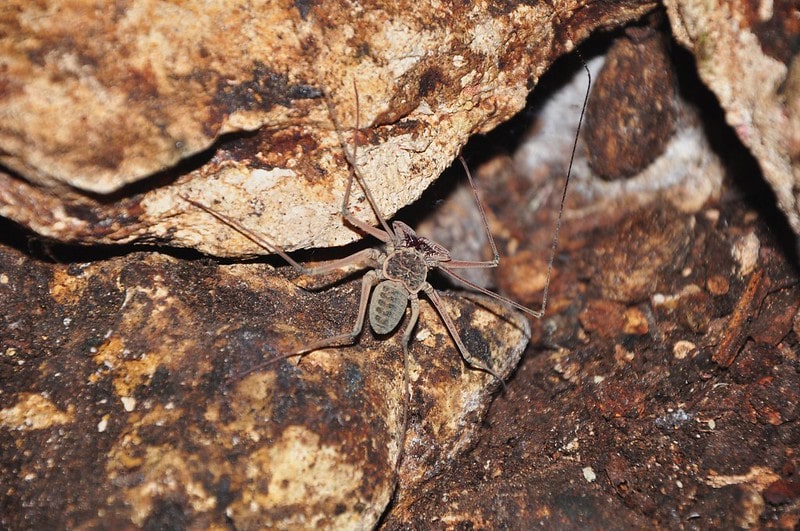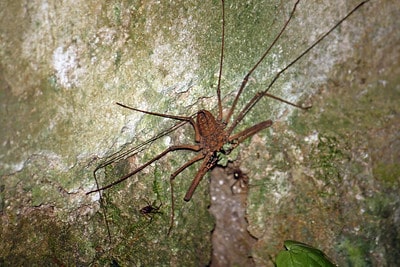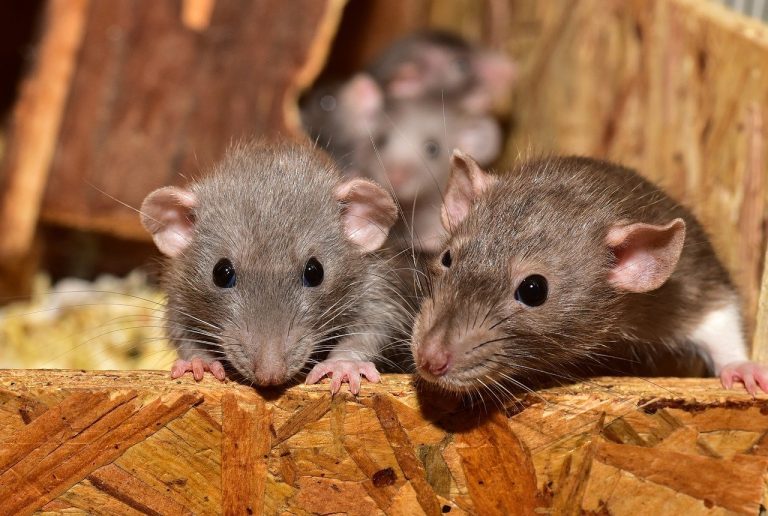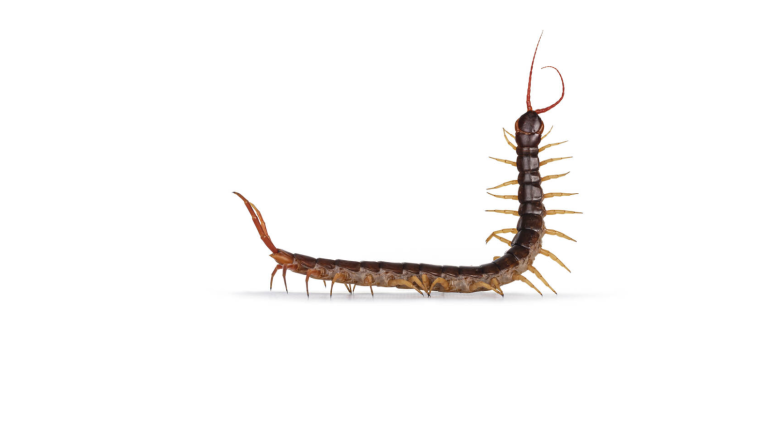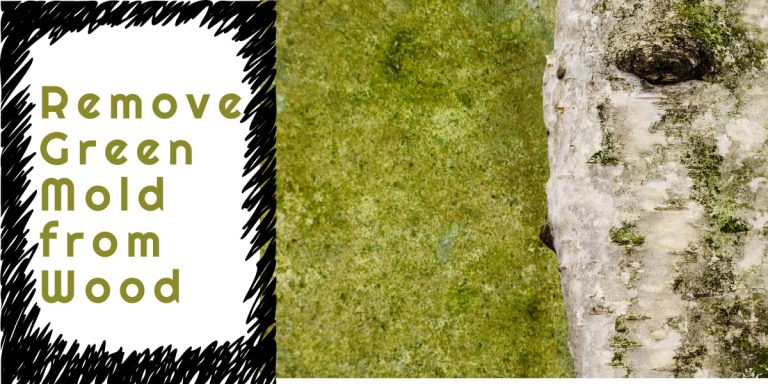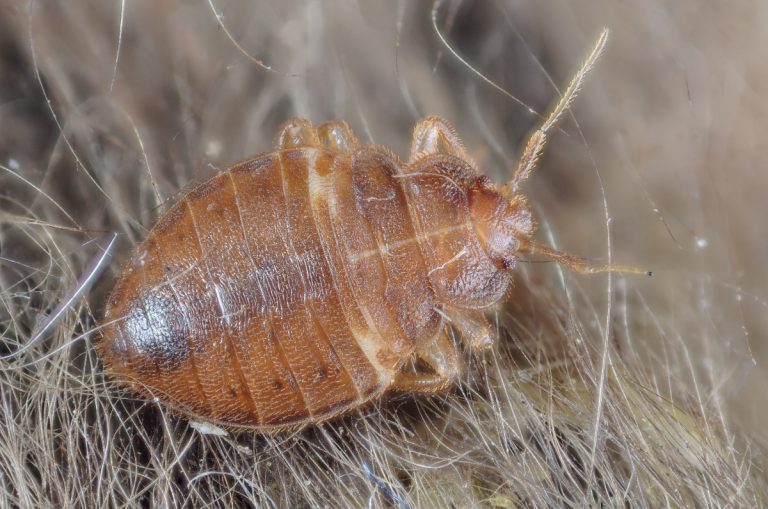Whip Spiders – All You Need to Know
Image of Whip Spider taken by Pavel Kirillov is licensed under CC BY-SA 2.0
Whip Spiders are small to large arachnids with large spiny pedipalps, a pair of two-segmented chelicerae, four pairs of legs, the first pair are greatly elongated and whip-like, and an ovate abdomen that lacks a terminal flagellum. Since 2016, 5 families, 17 genera, and around 155 species had been discovered and described. They are found in tropical and subtropical regions worldwide; they are mainly found in warm, humid environments and like to stay protected and hidden with leaf litter, caves, or underneath bark. Some species are subterranean, all are nocturnal.
They could range from 5 to 70 centimeters (2.0 to 27.6 inches) in leg span. Their bodies are broad and highly flattened, with a solid carapace and a segmented abdomen. Most species have eight eyes; a pair of median eyes, at the front of the carapace above the chelicerae and two smaller clusters of three eyes each further back on our side.
Whip Spiders range from 5 to 70 cm (2.0 to 27.6 inches) in leg span. Their bodies are broad and highly flattened, with a solid carapace and a segmented abdomen. Most species have eight eyes; a pair of median eyes at the front of the carapace above the chelicerae and two smaller clusters of three eyes each further back on each side. Whip Spiders have raptorial pedipalps modified for grabbing and retaining prey, much like those of a mantis. Recent work suggests that the pedipalps display sexual dimorphism in their size and shape. The first pair of legs act as sensory organs and are not used for walking. The sensory legs are very thin and elongated, have numerous sensory receptors, and can extend several times the length of the body.
Where do Whip Spiders live?
Whip Spiders have been found all over the world. They prefer tropical and subtropical regions. Their habitat can range from forests to grassland to dry mountainous areas where they nestle themselves in rock crevices or under debris. They have also been found under logs and rotten woods. They are common in forest habitats and can readily be seen in gardens on summer nights, suspended on delicate silk lines in spaces among the shrubbery.
A non-random occupation of habitats is termed habitat selection. Some species of Whip Spiders select trees with burrows at their base, while others use substrates such as rocks. Like C. asturius is more likely to be found under rocks that cover a large area of the substrate. C. asturius adults may be found again on the same rock.
What are the parts of the Whip Spiders?
- Two body parts (cephalothorax and the abdomen)
- A flat body shape with a total length of 5 to 7cm
- Eight legs- the six back ones for walking and the two long, thin front legs for sensing called antenniform.
- Enlarged and spiny pincers called pedipalps to catch prey
- Two eyes in the front and three eyes on each side (despite so many eyes, they don’t actually see very well)
Can Whip Spiders hurt you?
Whip Spiders worldwide, also known as tailless whip scorpions, have scared many because of their resemblance to venomous stinging scorpions. They are harmless to people, which they grab instead of bite.
Whip Spiders are completely harmless to us. They do not produce venom or toxins, nor are they capable of biting, stinging or injuring a person in any way. They do not transmit diseases and they are not pests. But they do have the misfortune of having a beautifully symmetrical, armored body that for some reason our primitive, stone-age psyche automatically associates with something bad or scary.
Like most arachnids these animals are predators. They are sit-and-wait hunters, using their first pair of extremely long antenniform legs to detect approaching prey, insects mostly, with an array of motion and scent-sensitive bristles and slit organs. Once the prey is detected within striking distance, the Whip Spiders pounces on it and crushes it with its spiny, muscular pedipalps. The prey is then masticated with smaller chelicerae and digested externally before the liquefied meal is directed into the mouth via grooves at the very base of the pedipalps.
In addition, Whip Spiders are passionate animals, both in love and war. Their courtship ritual is surprisingly elaborate and gentle and may involve hours of slow dancing, tender caressing, and handholding before the male places an external spermatophore on the ground and slowly guides the female to pick it up. After a while, she will produce a clutch of eggs and carry it on her body until the babies hatch. After their emergence, the young Whip Spiders, known at this stage as praenymphs, are still quite helpless, and the mother carries them on her body until they are ready to fend for themselves.
Where do Tailless Whip Spiders live?
Tailless Whip Spiders are found in the tropical part of North and South America, Asia, and Africa. They usually have a body length of 8 to 45mm (0.3 to 1.8 inches).The thorny-edge pedipalps seize prey, and the third appendages are long, whip-like feelers. They dwell under bark or stones, and they often enter homes. They are also present in forests, scrublands, and deserts. Tailless Whip Spiders live in caves, crevices, and under large boulders at most elevations. Since they are nocturnal they are seldom encountered by humans. At night in rocky, boulder-strewn areas and caves, adjacent to nature trails, one can find a Whip Spider.
Are Whip Spiders rare?
As these spiders belong to the paraphrynus genus and are found in abundance in tropic and sub-tropic regions across the world, there is no exact population count for this small spider species. A Whip Spider belongs to the class of arachnids. There are almost 151 surviving species, divided among 17 genera and further divided into four families.
A Whip Spider is extremely hideous and is easily considered to be dangerous which is totally incorrect. Since this species is venomless and retreats immediately if it senses threats. Whip Spiders have a flat body with a color ranging from yellowish-brown to dark brown, with dark spots all over their bodies. Their palpies are powerful and large which resembles the pincers of a scorpion. These pincers help it to grab and hold its prey. The leg of a Whip Spider has countless sensory organs but they do not use their first legs to walk.
Are Whip Spiders good pets?
Whip Spiders are good pets. They are one of the most bizarre-looking pets you will ever find, they exhibit very interesting behavior, and they are very hard in captivity. While they may look menacing, they typically have a very docile nature, and as mentioned, are completely harmless to humans. They can defend themselves with their claws but are more likely to run away when threatened. Whip Spiders can be flighty, and they are very fast, so, handling is not recommended. Whip Spiders make excellent pets and are simple to care for, especially for people who want an arachnid but don’t want to be bitten by a spider.
Whip Spiders make good pets. Many species of Whip Spiders pet are available in stores across the globe such as Paraphrynus Mexicanus, Acanthophrynus coronatus, Euphrynichus amanica, Damon medius, Phrynus marginemaculatus, Damon diadema, and Heterophrunus batesii. A Whip Spider is easy to take care of because they are easy to feed and does not require any special care. As they are nocturnal in nature, you might have to play with them at night.
How to take care of Whip Spiders?
In the wild, Whip Spiders are insectivores primarily. In captivity, it is given meals of crickets, roaches, and occasional wax worms. Sometimes if your Whip Spiders isn’t too shy, you can even get it to accept an insect from tongs. Like all arachnids, Whip Spiders molt as they grow. However, unlike most spiders, they require a place to hang from while molting. Most arachnids will molt on the ground, but Whip Spiders need a vertical space to hang from while they wriggle out of their old exoskeleton. Therefore it is absolutely imperative that owners provide a surface that the Whip Spiders can cling to in order to perform this behavior.
Directly following a molt, your Whip Spiders will be white or green in color and will be far more vulnerable. This means that prey items such as crickets or roaches that can bite your Whip Spider need to be removed immediately from the cage if they are not eaten. Kindly note that prey can actually injure the Whip Spiders while it is green or white, but after a few days, your Whip Spider’s new exoskeleton will harden and you can resume feeding as normal. Whip Spiders are fairly active arachnids, so, a decent-sized enclosure is recommended.
As previously mentioned when molting was discussed, be sure to have multiple angled surfaces with various textures that your Whip Spiders can cling to and hang from while molting. And as far as the substrate is concerned, anything that holds moisture is better off. Be sure to maintain high humidity levels in your Whip Spiders’ enclosure. They need humidity to thrive and go through proper molting. A good way to maintain humidity is to mist your Whip Spiders’ enclosure. This is also helpful because Whip Spiders won’t drink from a standing water dish, but they will drink water that has naturally collected in cage decor.
They make good pets since they are cheap to keep and do not require much attention. They eat small to medium-sized insects like crickets and do well with misting for water consumption. Whip Spiders enjoy more vertical adventures so having a climbing area is beneficial in a cage. These Whip Spiders can be held and handled and are usually fine at room temperature without needing a heat lamp.
How long do Whip Spiders live?
Whip Spiders can live up to seven years of age and they molt three times during their youth until they mature. They spend almost four years in their adult form.
In addition, mating takes place in the fall. A complex mating ritual lasts eight to twelve hours. The male secretes and transfers a sperm sac (spermatophore) into the female. She carries the eggs internally for several months and then lays 30 to 40 eggs in a fluid-filled sac held under her abdomen. She remains in her burrow holding the egg sac off the ground for an additional two months. The mucous membrane helps preserve moisture, allowing the eggs to develop. The young are white in color when they hatch from the eggs and then climb onto their mother’s back for about one month. Once the first molt is complete, the second young ones look like miniatures of the adults. At this point, they leave their mother’s burrow. The mother Whip Spider completing her life cycle dies soon after.
How big can a Whip Spider get?
Whip Spiders is also known as the tailless whip scorpion. They are both similar in appearance except for the tail. The Whip Spiders can grow up to be 0.3-1.8 inches (8-45mm) and their whips are bigger than their entire body.
Compared to Goliath birdeater which is the largest spider species, this creature is harmless and non-venomous.
How do Whip Spiders reproduce?
Here is another reason why you shouldn’t judge Whip Spiders by their appearance; they have gentle habits for mating and child-bearing. It starts with males and females completing a courtship ritual. They will feel each other out with their antenniform legs, stroke each other’s bodies, and perform little dances together. They don’t rush the courtship process; it can take hours for both parties to be ready for the next step. When it’s time to breed, the male will lay spermatophores on the ground and guide the female to pick them up. Physical contact isn’t actually needed for copulation. After securing the sperm, the female will produce eggs that she will carry on her back until hatching time.
Whip Spiders usually mate in the fall. After mating, the female carries the fertilized eggs inside her for a few months. When the eggs are laid, the female carries them in a fluid-filled sac under her abdomen. Each sac has 30 to 40 eggs. The female makes a burrow and sits with the egg sac for about two months. During this time, this dedicated mother does not move and makes sure the egg sack does not touch the ground. Once the eggs hatch, the nymphs climb on their mother’s back and stay there for a month until they molt. After molting, they leave and venture on their own. The females only produce one egg sac in a lifetime. After she delivers the nymphs she soon dies due to starvation and weakness.
In addition Whip Spiders also reproduce as scorpion does by the male depositing a spermatophore to the female who then carries the egg under her body until the babies are hatched. The babies then stay on the mother’s back until after their first molting at which point they leave the mother. Since the weather is so conducive to reproducing in the tropical regions, the mating season is endless.
What are the unique features of a Whip Spider?
These are really very interesting creatures. These arachnids like to be in groups until sexual maturity. Sexual behavior in arachnids is rarely observed, so it’s a unique characteristic. Whip Spiders fight with a dance. Although these arachnids have weapons they hesitate to use them with each other.
When there is a fight, two arachnids circle and softly probe each other with their whips. This is followed by a jerky motion and rapid vibration of their whips that do not touch the opponents. One fighter usually retreats, only 27% of the time is there a violent fight. A Whip Spider could decide to retreat; it is related to the hair on their legs known as trichobothria. When the arachnids are using their whips, the hairs on their legs respond to the vibrations being created. It has been observed that if the hair on the legs is shaved off, the arachnids indulge in more violent fights that last longer.
How do Whip Spiders catch prey?
Whip Spiders are arachnids with enlarged spiny pedipalps and elongated antenniform forelegs. These antenniform legs contain at least seven giant sensory neurons with no known behavioral function. When presented with a prey item, a Whip Spider first accurately aims one of its antenniform legs in the prey’s direction. Next, the Whip Spiders orients its body to the prey item and approaches, placing one antenniform leg tip on either side of the prey. The Whip Spiders may remain relatively still in this position for some time, before opening its pedipalps in preparation for a strike and then rapidly swinging its antenniform legs away from the prey items and striking at it with its pedipalps.
What class of animal does a Whip Spider belong to?
A Whip spider belongs to the arachnids’ class of animals and the funnel weaver genus. Arachnids include species containing spiders which make up the largest order alongside scorpions, mites, and ticks. Arachnids’ adults can be distinguished by their eight legs; however, the pair of front legs in some species of arachnids serves the function of a sensory gland. In other species, extra pairs of legs are formed by different appendages that have grown large enough. There are over 100,000 named arachnid species with the majority being terrestrial (land dwellers) while a few of them also inhabit freshwater and also, marine environments.
What are the threatening vibes of Whip Spiders?
If any group of animals looks like a nightmare made real, it’s the Whip Spiders. Also known as whip scorpions, these creatures look like flattened versions of true spiders, and they are close relatives of their namesake. Their front pair legs have been transformed into long whips which they flail ahead of their bodies to search for prey. Anything unfortunate enough to make contact gets grabbed by the Whip Spider’s massive pincers, each twice as long as the animal itself and tipped in fiendish spikes.
Despite these fearsome weapons, fights between Whip Spiders are more sedate affairs. They are more like dances, carried out to strict protocol and consisting largely of bad vibes. Two Whip Spiders circle one another and start gently probing each other with their whips. These movements become increasingly jerky and intense until the spiders start rapidly vibrating their whips in front of their opponents, without touching them. At this point, one fighter usually retreats. Naive individuals only come to blows in 27 percent of contests and experienced ones only attack 9 percent of them.
The vibrating whips of Whip Spiders are the key to a speedy resolution. The Whip Spiders Phrynus marginemaculatus detects these vibrations with exquisitely sensitive hairs known as trichobothria, found along their legs. A few years ago, the duo recorded electrical signals from the hairs and found that they respond to vibrations of the same frequency as those made by the whips. When the hairs from rival Whip Spiders are shaved, the threat displays will be on for around two times as long, and it is three to four times more likely to escalate into physical fights. Vibrations allow the combatants to showcase their physical strengths. This gives them enough physical information to save energy and avoid injury, by calling off a fight if they know they are going to lose. Similar hairs are found throughout the arthropods, which is the group that includes insects, spiders, scorpions, crustaceans, and so on. The Whip Spiders vibration-based messages could be a common style of communication within this varied group.
What are some of the additional information about Whip Spiders?
Whip Spiders do not build webs and they have long claws. They look terrifying and are actually delicate, timid, and afraid of you. These are other things about a Whip Spider:
- Whip Spiders care for their young. After they mate, the female lays egg and protects them. When babies hatch, they crawl onto their mother’s back; the mother carries them for a number of weeks, and in some species, may care for several months or more.
- Fathers seem to have a limited, if any, role in the lives of their babies.
- The spiders fight to protect their territory, and are aggressive with one another.
- They eat crickets, cockroaches, grasshoppers, small lizards and hummingbirds. Some even eat members of their own species, often at the end of a fight between two adults.
- Whip Spiders are eaten by bats and large lizards.
- They have a good sense of direction and can find their way back to their territory.
- They live on all continents, especially in warmer climates, including in deserts, caves and tree trunks. In the U.S, they live in the Southwest and Florida.
What about the Whip Spider’s habitat?
As mentioned before, the Whip Spiders thrive in humid tropical and subtropical habitats around the world. They dwell in caves between rocks, and under pieces of bark. Often one tree will be home to many individual Whip Spiders. They are very difficult to find during the day and only come out to hunt at night. While they are not harmful to humans, they are aggressive towards one another and to their prey. If these Whip Spiders are removed from their habitat and placed even ten meters away, they are able to use their sensory organs to navigate directly back to the place from which they were removed.
The habitat of Whip Spiders depends on the species. While all of them prefer dark, secluded places where they aren’t vulnerable predators, they can differ on specifics of where they lurk:
- Phrynus marginemaculatus lives under the leaves and rocks of the jungles of South America.
- Damon diadema hides under logs in Africa.
- Phrynus longipes lives in the caves of the Caribbean.
- Charon gyayi also lives in caves, but they are native to Asian countries like Malaysia, Indonesia, Singapore and the Philippines.
Is it a Spider with Claw?
While the Whip Spider’s name is a misnomer since it is in fact a scorpion. This spider is a close relative of a scorpion and shares similar characteristics. The spiny claw-looking appendages are actually an extension of the jaws of a scorpion and therefore are not the same as claws on a spider. The Whip Spiders actually works on the set of three legs with the first pair of appendages being sensory organs that aid in mating, locomotion, and finding prey.
What to know about the Whip Spider’s bite?
Though they may be able to bite or draw blood with their pedipalps, they do not have any venom glands. It is rare that these creatures would attack and bite a human since they are more apt to run short distances to escape any danger. If a bite does occur though, it needs to be treated with basic first aid care by cleaning and disinfecting the wound and bandaging.
What is the population of Whip Spiders in the world?
As these spiders belong to the paraphrynus genus and are found in abundance in tropic and sub-tropic regions across the world, there is no exact population count for this small spider species.
What is Whip Spider’s conservation status?
Whip Spiders belong to the class of arachnids and they are found in the tropical and subtropical regions across the globe. They play an important role in the ecosystem by eliminating other pests by preying on them as a source of food. An accurate number of their population is hard to come by due to data deficiency but it can be assumed that they are thriving and have a high population. According to the International Union for Conservation of Nature (IUCN) Red List of Threatened Species, Whip Spiders are not extinct.
What do Whip Spiders look like?
Whip Spiders look freakish but are an eye-catching species and because of their appearance, people are afraid of them and consider them to be dangerous and poisonous. Whip Spiders only become aggressive when it comes to defending their territories. Despite their hideous appearance, they are harmless to humans and tend to run away if threatened.
Most species of Whip Spiders have four pairs of eyes, a firm carapace with a subdivided abdomen. Whip Spiders have flat and broad bodies with eight legs, but they use only six legs to walk. They also use pair pedipalps to grab and retain their prey and their first pair of legs is used as sensory glands. Sometimes it looks like they have an extra pair of legs which are formed by different appendages that have grown large enough. Their legs have several sensory glands. These spiders are found in places that are hot and humid. A few species of Whip Spiders are nocturnal in nature and they spend most of the day time under rocks, barks, and leaves. Whip Spiders use their pincers to grab and hold their prey as they hunt for food.
Are Whip Spiders cute?
These species of spiders are extremely hideous with their flat look and they appear to have 10 legs. Their legs are extremely thin and their front pincers is portrayed as a whip.
How do Whip Spiders communicate?
Just like other species of spiders, Whip Spiders communicate using touch and vibration senses known as seismic communication. A female amblypygi communicates with her spiderlings by using her long antenniform front legs.
Can Whip Spiders run very fast?
Accurate data on their speed cannot be found, these spiders are known for their quick running speed. When they are in danger or sense predators around, they start running rapidly.
What do Whip Spiders eat?
Whip Spiders are opportunistic predators and their diet consists of grasshoppers, cockroaches, small lizards, and crickets. A Whip Spider can survive without feeding for over a month and these spiders do not eat during or after they molt.
Are Whip Spiders poisonous?
No, they are not poisonous. They are harmless to humans as they do not possess a silk gland or venomous fangs. They do not bite but they use their pedipalps to grab when they feel threatened.
The different types of Whip Spiders, both the American spiders and the Florida spiders are not true spiders since they do not produce any venom or silk. Their name is derived from the look of their first pair of legs. A Whip Spider’s bite can be extremely painful causing itching and severe pain. An African Whip Spider is also known as Damon variegatus, Damon annulatipes, and phrynichodamon Scullyi.
A giant Whip Spider is found near rocky mountain streams of tropical rainforest on Caribbean islands. They position themselves at the edge of the stream with their pedipalps ready and extended while entering the shallow water with their antenniform legs. They prey on freshwater prawns while submerged in water. A Whip Spider molts while hanging upside down and it uses gravity to assist itself when it separates from its exoskeleton.
A Whip Spider has four pairs of legs, but they use only six legs to walk sideways just like a crab. This creature has a good sense of direction and it can find its way back to its territory without any difficulty. Once the eggs are hatched, they climb on top of their mother’s back and if any fall off before their first molt, they may not survive. If there was a showdown between a Whip Spider and a scorpion, neither would win as they are both venomous and neither would be able to kill the other one.
What happens to a mother Whip Spider after laying her eggs?
The average litter size of the female Whip Spider is about 30 to 40 eggs and females incubate them alone without the help of a male. Once the eggs are hatched, a female will carry her spiderlings on her back and provide food and protection till their first molt. It has been found that a female will give up her prey for her spiderlings and die due to starvation.
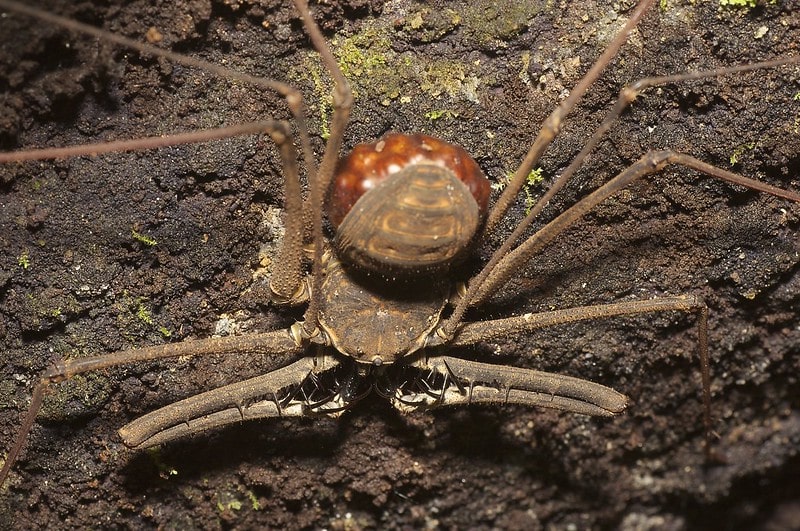
Why does it look like the Whip Spiders have ten legs?
Just like other species of spiders, a Whip Spider has four pairs of legs, but they use only six to walk. The front legs are used as sensory organs rather than for walking and the pair of pincers in the front appears as an extra pair of legs making them look like they have 10 legs.
What would you call a baby Whip Spider?
A baby Whip Spider is called “spiderling”. After hatching, spiderlings climb on top of their mother and stay there until their first molt.
How do the Whip Spiders hunt?
As nocturnal animals, Whip Spiders do all their hunting at night. They sit and wait for predators that lurk in the darkness and allow their unsuspecting victims to come to them. They will sometimes hide under leaves or rocks to give themselves an even greater advantage. Once their prey is within striking distance, the Whip Spiders have a few different methods to attack. One is a quick and decisive lunge that basically skewers the insect on its pincers before the insect has a chance to react.
Another tactic is to slowly feel around the insect with their antenniform legs in a non-threatening way before they switch gears and grab it. It’s rare for an insect to escape the clutches of a Whip Spider once they have been turned into a shish kabob. If they don’t die right away, they die once the Whip Spiders start using their mandibles to crush them.
Can Whip Spiders live together?
Whip Spiders are solitary creatures by nature, but they do live together in densely populated areas like caves. They will hunt around each other instead of engaging in territorial disputes. The one exception to this harmony is when they have dominant battles. Dominance battle can be surprisingly ferocious, and the victor might even decide to kill and eat the other. It starts with two members of the species feeling each other out with their antenniform legs. Oftentimes, one party will recognize the size or strength of the other and disengage without challenging them.
If they can’t decide which one of them is bigger or tougher, however, the Whip Spiders will start to escalate their aggression. Their touches will turn into pinches, and they will begin striking and grappling each other in earnest. These fights usually end in death. Occasionally, they will also end in cannibalism. The victor will munch on their foe’s body before moving right along.
Are Whip Spiders aggressive?
Despite their frightening appearance, Whip Spiders are not an aggressive species. They are not hostile or defensive, and they can co-exist, with one another in the wild. They also make docile pets. You can let Whip Spiders crawl all over your face without fear that will hurt you.
How do Whip Spiders move?
Whip Spiders have a sideways walk that’s a bit like a crab. They are capable of moving forward and backward, especially when hunting, but the sideways walk is the most common. They creep slowly while using their feelers to get feedback on the world around them.
How often do Whip Spiders molt?
Whip Spiders will molt several times in their life. This is a dramatic process where they shed their old exoskeleton and grow new ones. They will even change colors while they are molting, they will look blue, green, or pure white. The first molting happens just a few weeks after birth when they transform from embryonic babies into more juvenile nymps. They will molt several more times during their younger stages of life, and they will keep molting at a slower pace throughout adulthood. This is very different from other arachnids that only molt when they are juveniles and stop when they are adults.
Do Whip Spiders carry diseases?
Whip Spiders carry no known diseases. Since there are so many species, it’s impossible to say that they are disease-free. But nothing has been discovered yet.
What are the baby Whip Spiders like?
Newborn Whip Spiders are completely helpless. They are small embryonic creatures that are white in color, and they continue to cling to their mother’s back for several weeks after hatching. They only drop off when it’s time to molt into their second, more independent form.
Are the Whip Spiders endangered?
The Whip Spiders are not endangered on the whole, but some species are at risk more than others. For example, the IUCN has the Indian Ocean Whip Spiders listed as “vulnerable.” There are also several species that have gone extinct.

